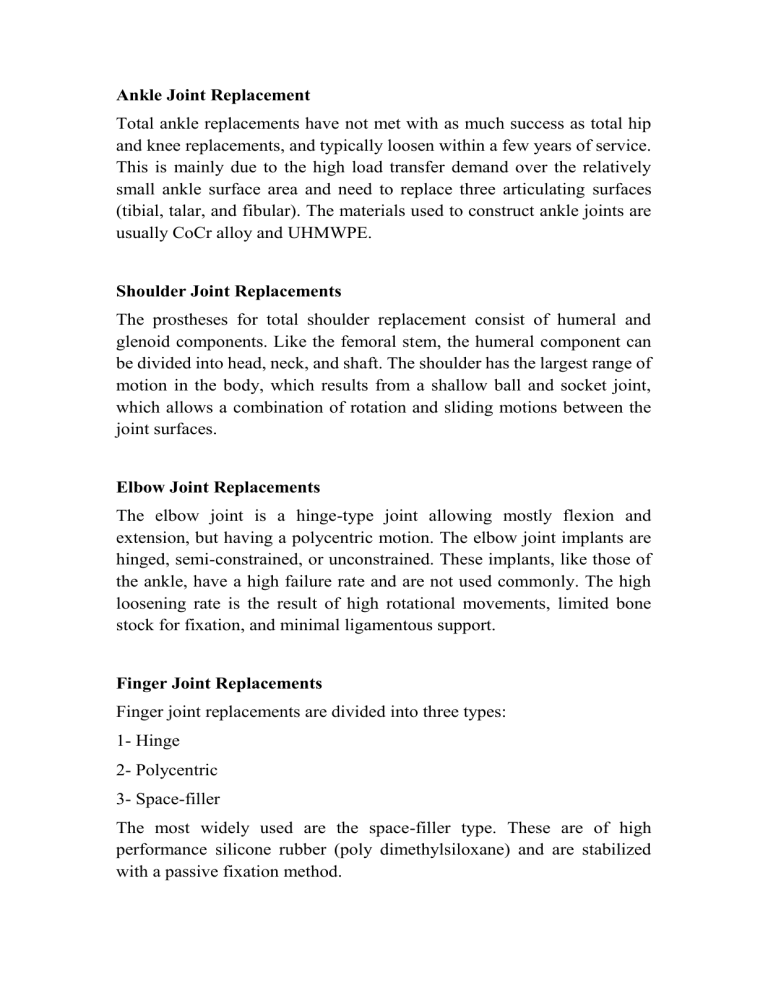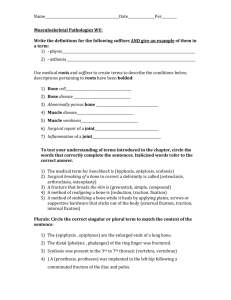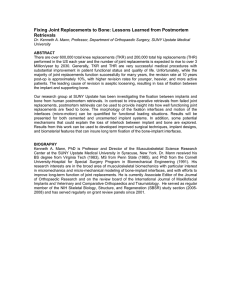Ankle Joint Replacement

Ankle Joint Replacement
Total ankle replacements have not met with as much success as total hip and knee replacements, and typically loosen within a few years of service.
This is mainly due to the high load transfer demand over the relatively small ankle surface area and need to replace three articulating surfaces
(tibial, talar, and fibular). The materials used to construct ankle joints are usually CoCr alloy and UHMWPE.
Shoulder Joint Replacements
The prostheses for total shoulder replacement consist of humeral and glenoid components. Like the femoral stem, the humeral component can be divided into head, neck, and shaft. The shoulder has the largest range of motion in the body, which results from a shallow ball and socket joint, which allows a combination of rotation and sliding motions between the joint surfaces.
Elbow Joint Replacements
The elbow joint is a hinge-type joint allowing mostly flexion and extension, but having a polycentric motion. The elbow joint implants are hinged, semi-constrained, or unconstrained. These implants, like those of the ankle, have a high failure rate and are not used commonly. The high loosening rate is the result of high rotational movements, limited bone stock for fixation, and minimal ligamentous support.
Finger Joint Replacements
Finger joint replacements are divided into three types:
1- Hinge
2- Polycentric
3- Space-filler
The most widely used are the space-filler type. These are of high performance silicone rubber (poly dimethylsiloxane) and are stabilized with a passive fixation method.
Implant Fixation Method
Fixation of implants with polymethyl-methacrylate (PMMA, bone cement) provides immediate stability, allowing patients to bear all of their weight on the extremity at once. In contrast, implants which depend on bone ingrowth require the patient to wait about 12 weeks to bear full weight.
Being a viscoelastic polymer, it has the ability to function as a shock absorber. It allows loads to be transmitted uniformly between the implant and bone, reducing localized high-content stress. The problems with bonecement interface may arise from intrinsic factors, such as the properties of the PMMA and bone, as well as extrinsic factors such as the cementing techniques.
Porous Ingrowth Fixation
Bone ingrowth can occur with inert implants which provide pores larger than 25mm in diameter, which is the size required to accommodate an osteon. For the best ingrowth in clinical practice, pore size range should be
100 to 350 mm and pores should be interconnected with each other with similar size of opening. Commercially, pure titanium, titanium alloys, tantalum, and calcium hydroxyapatite (HA) are currently used in porous coating materials. With pure titanium, three different types of porosity can be achieved:
1- Plasma spray coating;
2- Sintering of wire mesh;
3- Sintering of beads on an implant surface.
Thermal processing of the porous coating may weaken the underlying metal (implant). Additional problems may result from flaking of the porous coating materials, since loosened metal particles may cause severe wear when they migrate into the articulation.
Using a
Polymethylmethacrylate
(PMMA) cement to adhere the metal to the bone
Using a porous metal surface to create a bone ingrowth interface
Bioceramic materials fixation
Type of fixation
Dense, nonporous, nearly inert ceramics attach to bone-growth into surface irregularities by cementing the device into the tissues or by pressing fitting into a defect (termed Morphology Fixation )
For porous inert implants bone ingrowth occurs, which mechanically attaches the bone to the material (termed
Fixation )
Biological
Dense, nonporous, surface-reactive ceramics and glass-ceramics attach directly by chemical bonding with the bone (termed
Bioactive Fixation )
Example
Al
2
O
3
(single crystal and polycrystalline)
Al
2
O
3
(porous polycrystalline) hydroxyapetite-coated porous metals
Bioactive glasses, bioactive glass-ceramics, hydroxyapetite
Dense nonporous (or porous) resorbable ceramics are designed to be slowly replaced by bone
Calcium sulphate(plaster of
Paris)Tricalcium phosphate,
Calcium phosphate salts




